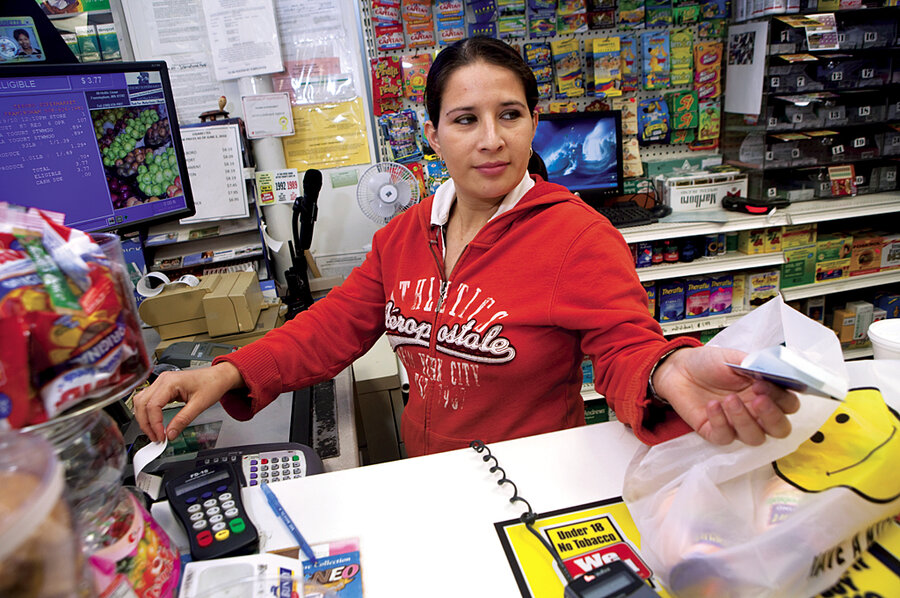Recession officially over, use of food stamps stays at record high
Loading...
| Rochester, N.Y.
Before the recession, Mary Ellen Hayden was living an active New York City life. She worked days at a corporate job, nights as a professional singer, taught as a substitute on occasion – and all as she was finishing her certification in secondary English education.
Then the recession hit and Ms. Hayden found herself out of a job and living on a shoestring budget in the most expensive city in the US.
"Things were drying up left and right," says Hayden, who had completed her bachelor's and master's degrees at private universities in the Northeast.
When a friend told her she could qualify for food stamps, she hesitated, but not for long.
"I was surprised it existed for me," says Hayden, who moved recently to more-affordable Rochester, N.Y. "And embarrassed because I'd never done it before. You think, 'Oh my gosh, I hope no one sees me.' It's a humbling experience for someone who's never been on it before."
The recession introduced millions of Americans to food stamps – many of them, like Hayden, for the first time. Now, more than a year after the recession is officially said to have ended, more Americans than ever are on food stamps, and the trend is higher still.
The obvious question is, why?
According to Dawn Secor, a food stamp specialist with the Nutrition Consortium, an antihunger nonprofit in Albany, N.Y., it was a combination of increased need and easier access.
Less of a stigma
Not only did the recession boost the number of people who qualify for food stamps because of layoffs and reduced incomes, says Ms. Secor, the ensuing Recovery Act increased food stamp benefits, provided states with extra funding for administering the program, and, most important, eased requirements and access, making many more Americans eligible.
The recession also erased some of the stigma associated with social services, says Susan Segelman, a Rochester-area nutrition outreach counselor. "Food stamps have become more acceptable," says Ms. Segelman. "Times are tough for everyone.… People aren't embarrassed to call, to apply."
According to the Department of Agriculture, about 41.8 million people, more than 1 in 8 Americans, use food stamps each month.
"The numbers of people utilizing the program are historical," says Secor. "It's more people than we've ever seen participate in the food stamp program.… We're struggling to keep up."
The first food stamp program in America began here in Rochester in 1939, during the Great Depression. Over the next 70 years, the program was alternately aborted, revived, cut, and expanded. Today the food stamp program – now officially called the Supplemental Nutrition Assistance Program, or SNAP – is a $60 billion safety net enjoying renewed support as a crutch that can expand and contract with the country's needs.
To be eligible for food stamps, a family can have a collective household income no more than 30 percent above the federal poverty level, meaning about $14,000 per year for an individual or $28,668 per year for a family of four.
An individual can receive up to $200 per month for groceries, and a family of four up to $668. Conspicuous paper coupons have been replaced by electronic cards that shoppers can use like debit cards, easing stigma and fraud.
"It's relatively invisible, that's a great strength of the program," says James Weill, president of the Food Research and Action Center, an antihunger advocacy organization in Washington, D.C.
Mr. Weill says he has seen food stamp participation skyrocket during the past few years, and predicts even more Americans will be swiping food stamp cards at the register for months to come.
The program has already grown from 26.3 million users per month in 2007 to almost 42 million in 2010. It's projected to reach 43.3 million users per month in 2011.
In September, the National Bureau of Economic Research announced that the recession had ended in June 2009. So where's the recovery?
The recession may be over, but the damage will take years to rebuild, says Weill. "All it means is that the decline in GDP [gross domestic product] stopped, but there's very little evidence that the loss of jobs and wages has stopped," he says.
Dottie Rosenbaum, a senior policy analyst with the Center on Budget and Policy Priorities, a Washington, D.C., research group that studies policies affecting low-income Americans, says she expects a jobless recovery that may look very much like a recession.
"What we've seen is we've hit bottom and the economy is turning around and growing, but it's still well below where it was two or three years ago," says Ms. Rosenbaum. "After every recession, poverty continues to rise for a year or more."
A responsive balm
During a slow recovery that may take years to trickle down to Main Street, food stamps, Rosenbaum says, have been and will continue to be a responsive balm for Americans across the country who struggle to meet an immediate need: how to put dinner on the table.
For Hayden, who reapplied for food stamps in August after she couldn't find a teaching job, food stamps have allowed her to focus her energies on returning to school for a dual certification in teaching English to nonnative speakers.
"I'm grateful for it," says Hayden, as she uses her benefits to shop for dinner fixings at the Rochester Public Market on a sunny Saturday in October. "You pay into the system, and when you need it, it's there."





